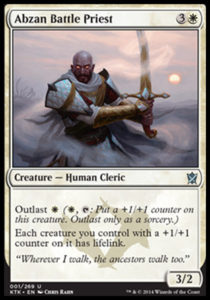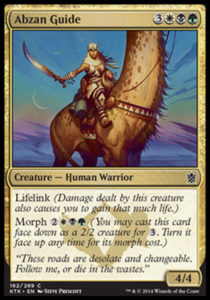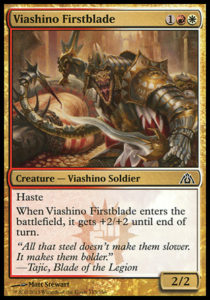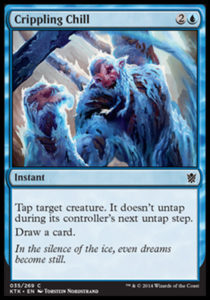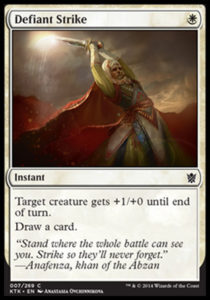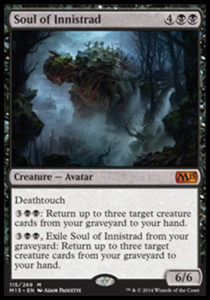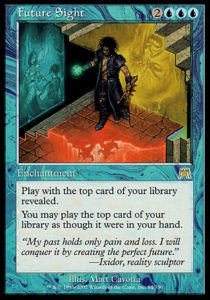Khans of Tarkir is here! This weekend, players worldwide had their first chance to play a brand new Limited environment. From what I’ve seen and heard, Khans didn’t disappoint. The format has a high power level, large amount of removal, and exciting, but tense board states (thanks to the clan mechanics and morph).
I had the opportunity to play in two sealed events—Jeskai in the morning (1-1; had to leave early) and Temur in the afternoon (3-1; didn’t have to leave early). Here’s what I learned:
Abzan is nuts
First off, the bad. Playing against Abzan was difficult and often demoralizing. Every game that I lost, I lost to an Abzan deck. Every one of those games was decided by one thing: lifelink.
The Abzan deck would hit me once with an Abzan Guide (a difficult creature to remove) or a creature buffed by Abzan Battle Priest, granting them another turn. Then another turn. Then another turn. All the while, my opponent was using Outlast to power up their forces and stonewalling my ground offense with their high toughness creatures. Eventually, their creatures were bigger than any threat that I could possibly muster or their life total was higher than I could ever knock down, and I’d be done in (slowly, over the course of many turns where the game steadily slipped farther and farther away from me).
Abzan seems the best long-game deck in the format: it combines lifelink’s ability to stay in the game, GWB’s strong defensive creatures, some of the best removal in the format (particularly Debilitating Injury and Smite the Monstrous), and Outlast, which guarantees that Abazan’s creatures will (eventually) be better than the opponent’s. Oh, and it also has great bomb rares.
Accordingly, there are two strategies I imagine players will need to adopt in Limited:
1. If you’re not Abzan, you need to be faster than Abzan. Your long game is worse than theirs. You need to have a plan for a turn five lifelink creatures.
2. If you are Abzan, you need to be able to quickly stabilize against the fast decks and have a plan for the mirror match (which often devolves into a staring match until someone gets the better +1/+1 lord or gets started Outlasting first).
Hopefully draft will make life less easy for the Abzan player, but I’m concerned that Sealed Grand Prixs/Pro Tour Qualifiers will be a sea of Junk.
Two-color aggro is still a thing
or…
Some find Aggro Unbearable
Khans is full of powerful tri-color cards. Playing only two colors denies you access to them (and the plentiful fixing that make them ‘easy’ to cast). However, let’s look to the past for guidance: Dragon’s Maze was a similar format (powerful multicolor cards, strong incentive to be tricolor, a good fixing), but the dominant strategy was usually to stick to a single two-color pair (normally a Gatecrash guild). When you did, you’d always take the best card (for you) from each pick, never spend picks on fixing, and kill the opponent by curving out while they were still getting their colors together and playing ETB-tapped lands instead of creatures.
I believe that not only is such a strategy possible in Khans of Tarkir (given that there is such a smaller number of gold cards), but that it may be comparably dominant. I also believe that not all two-color pairs are created equally—just as the Gatecrash color pairs were safer bets than the Return to Ravnica ones (due to the unique draft structure), I expect that Khans will have better and worse aggressive color pairs. Which color pairs are these? I’d need to playtest and delve through the spoiler to know definitively, but I’d start by testing allied color pairs.
If you start a draft in an allied color pair, there’s only one clan you can move into (or a multi-clan, four+ color deck), but if you start in an enemy pair, you’ll have two options (which is safer). Accordingly, I expect that players will prefer to safely start a draft in either a clan or an enemy color pair (which is the safest bet). If this is the case, the more risky color combinations—WU, UB, BR, RG, and GW (and their respective dual lands)—should be underdrafted.
I had the opportunity to test this hypothesis in both of my sealed flights. My Jeskai and Temur pools were unexciting, so I opted to make two color aggro decks that splashed the third color. Here’s my Temur deck (I unfortunately don’t have the Jeskai decklist):
RG(u) Temur Aggro
| Lands (18) 7 Mountain 7 Forest 2 Island 1 Frontier Bivouac 1 Thornwood Falls Creatures (16) 1 Kin-Tree Warden 1 Highland Game 2 Leaping Master 2 Temur Charger 1 Ainok Tracker 2 Alpine Grizzly 2 Snowhorn Rider 1 Longshot Squad 1 Avalanche Tusker 1 Bear’s Companion 1 Riverwheel Aerialists 1 Tusked Colossodon Spells (6) 1 Tormenting Voice 1 Awaken the Bear 1 Dragon Grip 2 Bring Low 1 Treasure Cruise |
I was impressed. It turns out that in a format where folks are playing vanilla 2/2 morphs on turn 3, playing 3/1s (or even 2/1s) on turn 2 and 4/2s on turn 3 can be devastating. Combat tricks like Dragon Grip and Awaken the Bear (which, unexpectedly, I only cast on my apparently narcoleptic bears) were very strong, since opponents were inclined to trade their creatures to offset their slow starts. I expect to employ this strategy again once I begin drafting.
Doing things the Jeskai Way
Playing Jeskai felt like playing an all-in combo deck. If I could play Prowess creatures on turns 2, 3, and 4, then follow up with two spells (Crippling Chill+Defiant Strike being excellent common options), I would have lethal (or close enough that the game was mine). I even managed a turn 5 kill on the draw this way. If I got off to a slow start, my puny creatures were rarely able to bypass my opponents’ naturally larger threats (and I’d need a pretty spicy Prowess chain to hope to win).
I want to do more testing first, but I expect a good Jeskai draft deck to be UW or UR (with little or none of the third color) and rely heavily on having as many Prowess creatures and Defiant Strikes as possible. Defiant Strike is just perfect for the deck and likely isn’t of interest to Abzan or Mardu mages (who have outlasting to do/creatures to cast).
Sometimes, you’ve gotta Break Out the Good Stuff
It’s been a tradition in my Magic circle to draft older formats (to the best of my knowledge, we’ve been doing this since long before MODO made it standard for the two weeks before rotation). Last weekend, several friends and I congregated to draft triple Scars of Mirroding and triple Innistrad.
In Innistrad, I opened an Olivia Voldaren (one of the best cards in the format), immediately saw the red wasn’t open, and left her in the sideboard. My deck felt good enough that it didn’t need to greedily splash her, and indeed, it didn’t lose a match.
Innistrad UB Goodstuff
| Lands (17) 9 Swamp 8 Island Creatures (16) 2 Typhoid Rats 1 Invisible Stalker 1 Mindshrieker 1 Skirsdag High Priest 1 Stitcher’s Apprentice 1 Walking Corpse 1 Armored Skaab 1 Ghoulraiser 1 Markov Patrician 2 Selhoff Occultist 1 Stitched Drake 1 Makeshift Mauler 1 Moon Heron 1 Murder of Crows Spells (7) 2 Dead Weight 1 Silent Departure 1 Victim of Night 1 Butcher’s Cleaver 1 Forbidden Alchemy 1 Tribute to Hunger | Sideboard (1) 1 Olivia Voldaren |
What to Write about Next?
That’s all for this week. I’m curious what you’d like to hear about next time. Would you like more Khans Limited strategy? Should I write about Team Draft League, now that I’m back after a season off? Chat about my ongoing Modern adventures or my newly renovated Cube? Or something more unusual, like a Lessons from Life or piece on Magic card/set design? Leave a comment below and I’ll leave the decision to you.
And, as always, thanks for reading.
—Zachary Barash
twitch.tv/ZennithGP — Join the livestream!
Zachary Barash has been playing Magic on and off since 1994. He loves Limited and drafts every available format (including several that aren’t entirely meant to be drafted). He’s a proud Cube owner and improviser, creating entire musicals from scratch every week. Zach has an obsession with Indian food that borders on being unhealthy.

